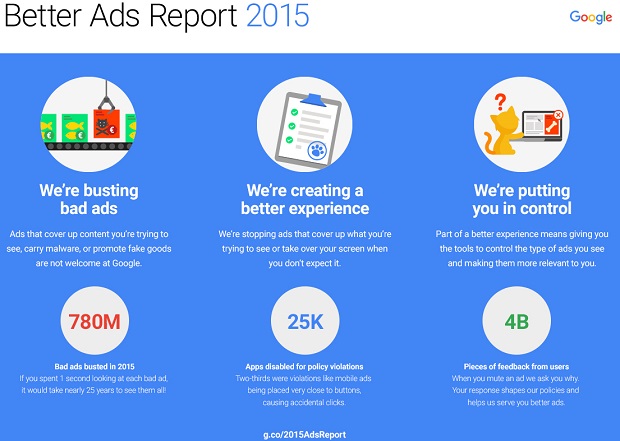Google disabled 780 million bad ads globally in 2015 as part of its continuing initiative to rid its network of ads that used sneaky tactics to get more clicks.
Announcing its annual ‘Better Ads’ report (changed from its old ‘Bad Ads’ label), the search giant said it blocked 780 million ads, up from the 524 million ads the company shut down last year and the 350 million they shut down in 2013.
Some 25,000 app accounts were disabled from carrying Google ads, mostly for violations like placing ads too close to a button so users accidentally click the ads, rather than the button as intended.
Also on that front, last June, Google made some changes to help minimize the impact of fat-finger clicks on mobile ads.
In all, Google says it rejected more than 1.4 million advertising account applications from apps and sites last year.
Sridhar Ramaswamy, head of Google ads, writes that future efforts will include “updates like further restricting what can be advertised as effective for weight loss and adding new protections against malware and bots.”
Read the official blog post here. Key findings republished below, written by Sridhar Ramaswamy, SVP, Ads & Commerce at Google.
Counterfeiters
We suspended more than 10,000 sites and 18,000 accounts for attempting to sell counterfeit goods (like imitation designer watches).
Pharmaceuticals
We blocked more than 12.5 million ads that violated our healthcare and medicines policy, such as ads for pharmaceuticals that weren’t approved for use or that made misleading claims to be as effective as prescription drugs.
Weight loss scams
Weight loss scams, like ads for supplements promising impossible-to-achieve weight loss without diet or exercise, were one of the top user complaints in 2015. We responded by suspending more than 30,000 sites for misleading claims.
Phishing
In 2015, we stepped up our efforts to fight phishing sites, blocking nearly 7,000 sites as a result.
Unwanted software
Unwanted software can slow your devices down or unexpectedly change your homepage and keep you from changing it back. With powerful new protections, we disabled more than 10,000 sites offering unwanted software, and reduced unwanted downloads via Google ads by more than 99 percent.
Trick to click
We got even tougher on ads that mislead or trick people into interacting with them—like ads designed to look like system warnings from your computer. In 2015 alone we rejected more than 17 million.
Creating a better experience
Sometimes even ads that offer helpful and relevant information behave in ways that can be really annoying—covering up what you’re trying to see or sending you to an advertiser’s site when you didn’t intend to go there. In 2015, we disabled or banned the worst offenders.
Accidental mobile clicks
We’ve all been there. You’re swiping through a slideshow of the best moments from the Presidential debate when an ad redirects you even though you didn’t mean to click on it. We’re working to end that. We’ve developed technology to determine when clicks on mobile ads are accidental. Instead of sending you off to an advertiser page you didn’t mean to visit, we let you continue enjoying your slideshow (and the advertiser doesn’t get charged).
Bad sites and apps
In 2015, we stopped showing ads on more than 25,000 mobile apps because the developers didn’t follow our policies. More than two-thirds of these violations were for practices like mobile ads placed very close to buttons, causing someone to accidentally click the ad. There are also some sites and apps that we choose not to work with because they don’t follow our policies. We also reject applications from sites and mobile apps that want to show Google ads but don’t follow our policies. In 2015 alone, we rejected more than 1.4 million applications.
Mute This Ad
Maybe you’ve just seen way too many car ads recently. “Mute This Ad” lets you click an “X” at the top on many of the ads we show and you won’t see a Google ad from that site again. You can also tell us why. The 4+ billion pieces of feedback we received in 2015 are helping us show better ads and shape our policies.
Ads Settings
In 2015, we rolled out a new design for our Ads Settings where you can manage your ads experience. You can update your interests to make the ads you see more relevant, or block specific advertisers all together.
Looking ahead to 2016
We’re always updating our technology and our policies based on your feedback—and working to stay one step ahead of the fraudsters. In 2016, we’re planning updates like further restricting what can be advertised as effective for weight loss, and adding new protections against malware and bots. We want to make sure all the ads you see are helpful and welcome and we’ll keep fighting to make that a reality.
